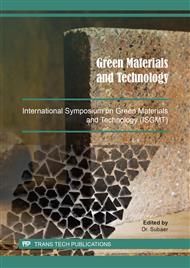[1]
A. Sedaghat and A. Bien-aime, Measurements and Predictions of Heat of Hydration of Portland Cement Using Isothermal Conduction Calorimetry.,.
Google Scholar
[2]
G. D. E. Schutter, GENERAL HYDRATION MODEL FOR PORTLAND CEMENT AND,, vol. 25, no. 3, p.593–604, (1995).
Google Scholar
[3]
S. Chithiraputhiran and N. Neithalath, Isothermal reaction kinetics and temperature dependence of alkali activation of slag , fly ash and their blends,, Constr. Build. Mater., vol. 45, p.233–242, (2013).
DOI: 10.1016/j.conbuildmat.2013.03.061
Google Scholar
[4]
R. W. Æ. G. V. A. Æ. B. Van Mele, Reaction mechanism , kinetics and high temperature transformations of geopolymers,, p.2982–2996, (2007).
Google Scholar
[5]
X. Yao, Z. Zhang, H. Zhu, and Y. Chen, Thermochimica Acta Geopolymerization process of alkali – metakaolinite characterized by isothermal calorimetry,, vol. 493, p.49–54, (2009).
DOI: 10.1016/j.tca.2009.04.002
Google Scholar
[6]
S. K. Nath, S. Mukherjee, S. Maitra, and S. Kumar, Kinetics study of geopolymerization of fly ash using isothermal conduction calorimetry,, J. Therm. Anal. Calorim., vol. 127, no. 3, p.1953–1961, (2017).
DOI: 10.1007/s10973-016-5823-x
Google Scholar
[7]
C. Li, H. Sun, and L. Li, Cement and Concrete Research A review : The comparison between alkali-activated slag ( Si + Ca ) and metakaolin ( Si + Al ) cements,, Cem. Concr. Res., vol. 40, no. 9, p.1341–1349, (2010).
DOI: 10.1016/j.cemconres.2010.03.020
Google Scholar
[8]
Z. Zhang, H. Wang, J. L. Provis, F. Bullen, A. Reid, and Y. Zhu, Quantitative kinetic and structural analysis of geopolymers. Part 1. the activation of metakaolin with sodium hydroxide,, Thermochim. Acta, vol. 539, p.23–33, (2012).
DOI: 10.1016/j.tca.2012.03.021
Google Scholar
[9]
Z. Zhang, J. L. Provis, H. Wang, F. Bullen, and A. Reid, Thermochimica Acta Quantitative kinetic and structural analysis of geopolymers . Part 2 . Thermodynamics of sodium silicate activation of metakaolin,, Thermochim. Acta, vol. 565, p.163–171, (2013).
DOI: 10.1016/j.tca.2013.01.040
Google Scholar
[10]
S. H. Lee, H. J. Kim, E. Sakai, and M. Daimon, Effect of particle size distribution of fly ash-cement system on the fluidity of cement pastes,, Cem. Concr. Res., vol. 33, no. 5, p.763–768, (2003).
DOI: 10.1016/s0008-8846(02)01054-2
Google Scholar
[11]
Z. Sun and A. Vollpracht, Cement and Concrete Research Isothermal calorimetry and in-situ XRD study of the NaOH activated fl y ash, metakaolin and slag,, Cem. Concr. Res., no. September, p.0–1, (2017).
DOI: 10.1016/j.cemconres.2017.10.004
Google Scholar


